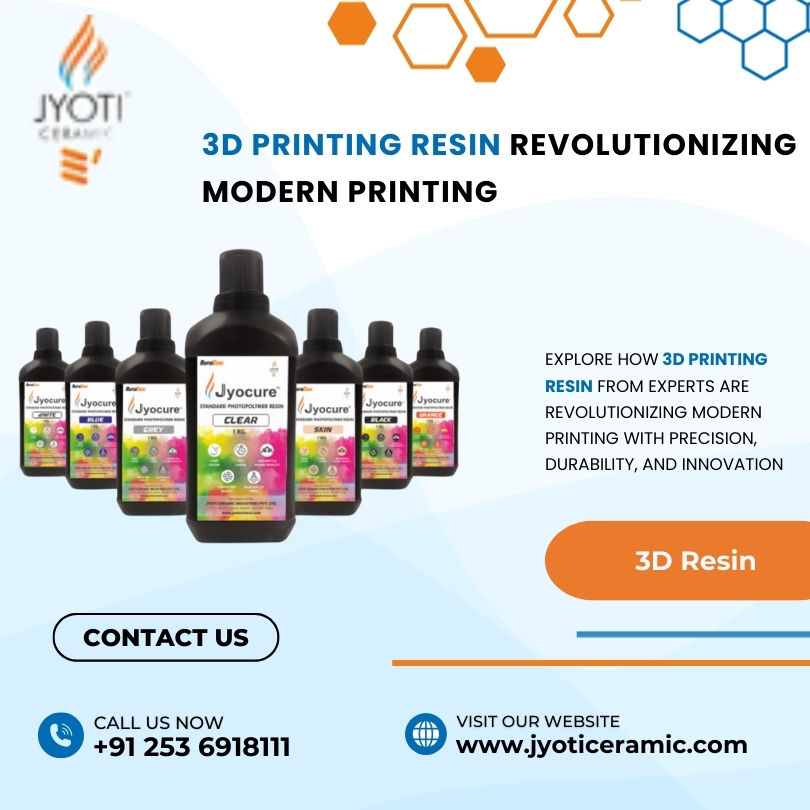Top Uses of 3D Printing Resin & 3D Resin in Modern Manufacturing
- Jyoti Ceramic
- Aug 18
- 4 min read
Discover the top applications of 3D Resin in modern manufacturing delivering precision, strength, and innovation.
The manufacturing world has been steadily shifting from traditional machining to advanced digital solutions, and one of the key drivers of this transformation is resin-based 3D printing. 3D Printing Resin has opened doors for industries to produce components that combine accuracy, efficiency, and reliability. Beyond their technical advantages, these materials are helping manufacturers reimagine processes and deliver products that meet modern demands.As material science continues to evolve, these resins will only grow stronger in shaping the future of manufacturing. With trusted suppliers like jyoticeramic , businesses can access advanced resin solutions tailored to their unique requirements as follows .

Rapid Prototyping for Product Development
The ability to create fast, low-cost prototypes is one of the greatest strengths of resin printing. Manufacturers can test new product designs quickly without the expense of tooling or machining. This flexibility allows engineers to refine shapes, test assembly compatibility, and even validate ergonomics before mass production begins.With 3D Printing Resin, prototypes closely resemble final products, giving companies confidence in design decisions and reducing time-to-market.
Custom Manufacturing and Personalization
Consumer demand has shifted toward personalized products. Industries such as fashion, eyewear, and healthcare require custom designs that fit individual needs. Resin printing enables scalable customization, allowing each product to be uniquely crafted without disrupting production efficiency.
For example, hearing aids and dental aligners are now widely manufactured using 3D Resin, giving patients a personalized solution that ensures both comfort and functionality.
Small Batch Production for Specialized Parts
Traditional manufacturing often requires large production runs to be cost effective. Resin based 3D printing eliminates this limitation, enabling small batch runs of high quality parts at lower costs. This is particularly useful for industries producing specialized components with limited demand.Manufacturers can create limited edition product lines, specialized tools, or replacement parts without investing heavily in molds or tooling. This approach saves costs while maintaining flexibility in supply chains.
Complex Design Structures and Lightweight Components
Some industries require intricate internal structures or lightweight designs that would be impossible with subtractive methods. With resin printing, lattice frameworks, hollow interiors, and ultra-thin features can be created with precision.In aerospace and automotive, these designs contribute to weight reduction while maintaining structural integrity. This balance of strength and lightness directly improves fuel efficiency, performance, and sustainability.
High Quality Visual Models for Presentations
Beyond functional applications, resin-based 3D printing also delivers highly detailed visual models. Businesses use them to showcase new concepts at trade shows, client meetings, or investment pitches. The smooth finish and precision detailing offered by Printing Resin make these models stand out as professional grade presentations.
Functional Testing and Engineering Validation
Engineers need prototypes to test parts under real-world conditions. Resin-based parts provide the necessary toughness to simulate stress, load, and environmental resistance.With 3D Resin, companies can evaluate performance characteristics such as durability, thermal resistance, and impact strength before investing in full manufacturing. This saves resources and prevents costly design errors.
Educational and Research Applications
Resin printing is becoming a vital tool in academic institutions and research facilities. Students use it to bring theoretical designs to life, while researchers test prototypes for experimental projects. The affordability and accessibility of resin-based printing make it a preferred choice for learning environments.
This exposure equips future engineers, designers, and innovators with hands-on experience, preparing them for roles in advanced industries.
Medical Applications and Healthcare Innovation
The medical sector has benefited immensely from resin based 3D printing. From anatomical models that assist surgeons in planning complex procedures to customized implants that improve patient recovery, the applications are endless.
Biocompatible resins allow for safe use in dental and orthopedic treatments, where precision and fit are critical. With rapid advancements, the healthcare industry continues to unlock new opportunities with this technology.
Tooling and Production Aids
Beyond final parts, resin printing also supports the creation of tools, molds that assist in production processes. Instead of waiting weeks for traditional tools to be manufactured, companies can create custom aids in-house within hours.This agility helps manufacturers stay competitive by reducing downtime, increasing efficiency, and lowering production costs.The applications of 3D Printing Resin in modern manufacturing are vast and transformative. From rapid prototyping and small-batch production to healthcare innovation and aerospace engineering, resins are empowering industries with precision, speed, and versatility.
FAQs
Q1. What makes resin-based printing popular in modern manufacturing? Resin-based printing is popular because it provides high precision, fine detailing, and smooth surface finishes that are hard to achieve with other materials. This makes it ideal for industries that demand accuracy and aesthetics, such as healthcare, automotive, and consumer products.
Q2. Can resin-printed parts be used in functional applications? Yes, depending on the type of resin chosen. Some are designed for durability and strength, while others are better suited for prototyping or decorative purposes. Selecting the right material ensures both performance and longevity in real-world applications.
Q3. How cost-effective is resin printing compared to traditional methods? While the initial investment may seem higher, resin printing often reduces costs over time by minimizing material waste, enabling rapid prototyping, and shortening production cycles. It also saves expenses linked to molds and tooling.
Q4. Is resin printing suitable for large-scale manufacturing? Resin-based printing is most effective for small to medium production runs and specialized parts. For mass production, traditional methods may still be more efficient, but resin printing excels when customization, speed, or detail is required.
Q5. What factors should be considered before choosing resin printing for a project? Factors such as required strength, flexibility, resistance to heat or chemicals, and desired surface finish should be evaluated. Additionally, the purpose of the part—whether it is for testing, functional use, or final product delivery—guides the choice of material and process.
Embracing resin-based printing is no longer just an option,it is a strategic advantage in today’s competitive industrial landscape.
Contact: +91 253 6918111



Comments